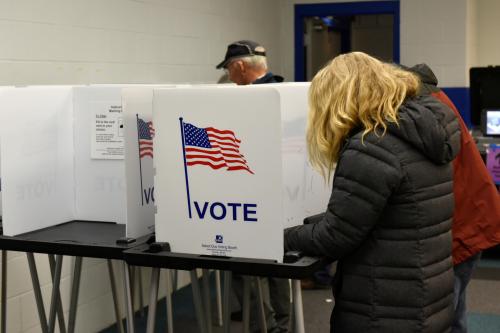Those working to accelerate economic growth in the Heartland must face some stark realities. The Great Lakes region continues to export wealth to coastal economies, even as investment leaders try to equalize growth between the coasts and the Heartland. The region sees only a tiny fraction of venture capital (VC) deals, despite producing one quarter to one third of the nation’s research and development, new patents, and top talent. Great Lakes VC funds are currently seen as too small or too unknown for investors—at a time when VC is funding fewer firms with bigger exits.
Given all of that, here’s an approach policymakers and investors could try to stem the export of capital from the region: A regional venture capital fund-of-funds. A recent analysis sponsored by the Brookings Institution and the Chicago Council of Global Affairs, and conducted by a team of University of Michigan Executive MBA candidates, suggested such a remedy.
A regional fund-of-funds would be a vehicle for in-region and out-of-region investors who put their dollars to work with investments in venture capital firms. The regional fund would allocate investors’ money into a network of well-run state and local/regional VC funds, and co-invest with them in promising companies. Such a fund would facilitate much-needed growth in the size and scale of the venture capital network in the Great Lakes/Midwest—allowing it to be competitive in today’s larger and later rounds of funding. This, in turn, would help transform more of the region’s prodigious innovation into new businesses and jobs locally—realizing good returns for investors and fueling economic transformation of the “Rust Belt” economy.
Such a program is not new. In fact, Frank Samuel, the architect of Ohio’s “Third Frontier” state investment fund, first proposed a “Great Lakes” regional venture capital fund in a 2010 Brookings paper.
The important role of venture capital
Many see the venture capital game as a flawed process that leaves entrepreneurs hostage to the ever-growing big dollar whims of a handful of (largely white and male) coastal multi-millionaires or foreigner investors. While VC isn’t perfect, and it certainly has its share of representation problems, it has also been an essential generator of both innovation and economic opportunity for the United States. For example, in recent decades VC has generated more economic and employment growth in the U.S. than any other investment sector. Annually, venture investment makes up only 0.2% of GDP, but delivers an astonishing 21% of U.S. GDP in the form of VC-backed business revenues.1
Most venture investments, like any other form of early-stage financing, fail. However, when venture-backed deals do pan out, they create an explosive growth dynamic, seeding the creation of additional local startups. These follow-on effects can foster a robust innovation ecosystem that helps sustain growth. Perhaps most importantly for transforming (and rebranding) the “Rust-Belt,” VC-backed companies are on the cutting edge of emerging sectors and technologies, rather than industrial or “old economy.” It’s venture-backed firms like Tesla, Beyond Meat, and Square that create the new businesses that help “superstar” cities like San Francisco, Boston, and New York to pull away from others, and enable secondary cities, like Austin, Seattle, and Boulder, Colo. to emerge as vibrant tech-hubs. As long as the venture capital game is being played, the Midwest needs to get its share.
Changes in venture capital make it hard to “find” Midwest innovation
As detailed in prior posts, the states that make up the industrial Midwest have innovation horsepower, punching at or above their weight on key metrics that drive new business formation. Home to a third of U.S. Fortune 500 companies, and 20 of the world’s top research universities (more than any other region), the Midwest generates:
- 26% of the nation’s corporate and university patents
- 31% of U.S. university-based research and development, including 34% of highly competitive National Institutes of Health (NIH) research funding, the key to creating new drugs and medical technologies
- 35% of the nation’s total bachelor’s degree holders
- 33% of its STEM graduates,
- 32% of all higher education degrees awarded in the United States
Normally, innovation metrics of this scale translate into significant new entrepreneurial activity, start-ups, and jobs.
But, the capital to commercialize this innovation and spark an entrepreneurial culture is lacking in the Midwest and across the broader U.S. Heartland.
New research confirms the case that the nation’s venture capital—including VC fueled by the Midwest’s large-scale university endowments, philanthropies, and state and local pension funds—is not finding the region’s innovations or helping turn them into new jobs and businesses. If anything, the dynamics of the venture-investing world, demanding ever-bigger investments and rewarding fewer and fewer big winners, are making growth prospects worse for the Midwest.
Dollar values for investments in different regions reveal great disparity that goes far beyond just total deal numbers. The six central Great Lakes Region (GLR) states had a similar total number of deals as Boston; however, the dollar values of the deals in Boston were 2.3 times larger than in the Great Lakes. Likewise, California had approximately five-times as many deals than the GLR in 2017, but their dollar amount was more than 12 times larger than GLR investments. This trend of larger deal sizes demonstrates a crucial feature of VC activity: higher deal values (and consequently larger company exits) are achieved on the coasts, and the gap between the coasts and the GLR is growing.

As Figure 2 indicates, Midwest venture funds are relatively few in number, smaller, and more dispersed across a broader geography than those in the large deal-making “hothouses.”

This further disadvantages the Midwest at a time when the venture capital industry is demanding larger funding rounds. Data from the National Venture Capital Association (NVCA) showed a steady increase in total number of VC deals from 2004 to 2015 (a five-fold increase), followed by a modest decline over the last two-to-three years. Despite the fewer number of VC deals in recent years though, total capital contributed climbed to an all-time high in 2017.
Midwestern venture investors who have good investment track records surveyed as part of the research clearly see the need for more capital to apply towards promising innovations. States like Illinois and Indiana are doing what they can to grow their capital base and homegrown startups through state-based investment funds. However, these efforts are sometimes circumscribed in their impact, as changing political leadership alters or ends programs, and geographic constraints don’t support return-driven ecosystem growth.
Nonetheless, the Midwest’s smaller funds can’t compete in a VC environment where there are fewer successful exits, more capital is required, and a growing risk-return ratio. For example, three recent billion dollar-plus exits in the region, Clever Safe, DUO, and Exact Target, had no meaningful capital from the Great Lakes.
Meanwhile Midwestern wealth subsidizes coastal investing
Ironically, the region generates a lot of wealth that is invested in venture capital. The Midwest is home to seven of the nation’s 25 richest universities in terms of endowments, and some of the largest foundations in the country. The region is also home to many public and private pension funds, with substantial resources under management. But as Table 1 indicates, given the small size and relatively modest number of venture capital firms at work in the region, its incredible wealth doesn’t often get put to work to grow new jobs and businesses. A sampling of some of the region’s large institutional investors showed they had collectively invested in 71 VC funds since 2008—but only one of the funds was managed in the region.

The Midwest needs effective solutions to counter this export of capital from the region, and create a new economic narrative and reality. One remedy could be to create a regional fund-of-funds.
A practical first step: A Great Lakes regional fund-of-funds
Researchers on this project, joined by a number of regional and national leading venture investors, have been scoping the most practical and effective plan to develop such a fund. Ideally, the fund would be private sector-led, and organized by experienced fund managers and investors who appreciate that the main goal is to help investors realize good returns alongside a complementary social impact mission, with a focus on the GLR. Additionally, there should be low or zero geographic constraints on where the fund can invest, and who can invest in the fund, as such constraints have tended to crimp similar fund-of-fund’s investment success and economic impact for the region. The fund should be a partnership of the region’s leading venture organizations and investors, as well as investors from Silicon Valley and others outside the region. Finally, it should offer a vehicle for finding good returns to investors that also grows the capital under management among the network of Great Lakes regional VC funds.
Starting with a $150 to $200 million fund pitched as a vehicle for institutional investors to make solid but relatively small bets ($5 to $10 million), among a network of emerging yet effective managers with experience in the region, would substantially decrease the risk in these investments. A particular focus could be in soliciting small initial investments from the region’s philanthropies, state pension funds, and university endowments. These institutions have significant assets under management, a history of venture capital investing, and are returns-focused—but they also share in the funds’ social mission and the ancillary benefits of enhancing the region’s innovation ecosystem, accelerating economic growth locally, and enhancing technology transfer and revenues from universities.
To that end, a regional fund-of-funds could be a key strategy for catalyzing new job and business growth in the upper Midwest, helping more workers find a place in a changing economy, and modernizing the narrative of a region that is truly one of the world’s leading innovation engines.
Greg Bjork, Vik Panchal, Amanda Richie, John Stephens, Darryl Won, and Jack Farrell of the University of Michigan contributed to this post.
-
Footnotes
- Annaleena Parhankangas, “The Economic Impact of Venture Capital” (Chicago: University of Illinois at Chicago, 2012).






